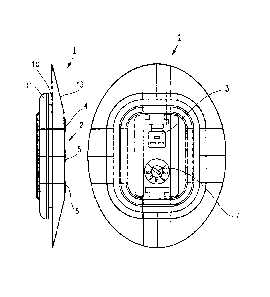Some of the information on this Web page has been provided by external sources. The Government of Canada is not responsible for the accuracy, reliability or currency of the information supplied by external sources. Users wishing to rely upon this information should consult directly with the source of the information. Content provided by external sources is not subject to official languages, privacy and accessibility requirements.
Any discrepancies in the text and image of the Claims and Abstract are due to differing posting times. Text of the Claims and Abstract are posted:
| (12) Patent: | (11) CA 2584954 |
|---|---|
| (54) English Title: | PROSTHESIS INTERNAL SHAFT SYSTEM |
| (54) French Title: | SYSTEME PROTHETIQUE A BROCHE INTERNE |
| Status: | Granted and Issued |
| (51) International Patent Classification (IPC): |
|
|---|---|
| (72) Inventors : |
|
| (73) Owners : |
|
| (71) Applicants : |
|
| (74) Agent: | KIRBY EADES GALE BAKER |
| (74) Associate agent: | |
| (45) Issued: | 2015-02-24 |
| (22) Filed Date: | 2007-04-16 |
| (41) Open to Public Inspection: | 2007-11-09 |
| Examination requested: | 2012-03-22 |
| Availability of licence: | N/A |
| Dedicated to the Public: | N/A |
| (25) Language of filing: | English |
| Patent Cooperation Treaty (PCT): | No |
|---|
| (30) Application Priority Data: | ||||||
|---|---|---|---|---|---|---|
|
The invention refers to a prosthetic internal shaft system with an internal shaft which is configured within a prosthetic external shaft with accommodation features for additional prosthesis components and has at least one recess for conduction of myoelectrical signals to an electrode located on the internal shaft, whereby the electrode is attached to the recess by a sealing fitting.
Linvention concerne un système prothétique à broche interne avec une broche interne qui est conçue avec une broche externe prothétique avec des caractéristiques de logement pour des composants prothétiques supplémentaires et qui possède au moins un évidement pour la conduction de signaux myoélectriques vers une électrode située sur la broche interne, au moyen de laquelle lélectrode est attachée à lévidement par un raccord détanchéité.
Note: Claims are shown in the official language in which they were submitted.
Note: Descriptions are shown in the official language in which they were submitted.

2024-08-01:As part of the Next Generation Patents (NGP) transition, the Canadian Patents Database (CPD) now contains a more detailed Event History, which replicates the Event Log of our new back-office solution.
Please note that "Inactive:" events refers to events no longer in use in our new back-office solution.
For a clearer understanding of the status of the application/patent presented on this page, the site Disclaimer , as well as the definitions for Patent , Event History , Maintenance Fee and Payment History should be consulted.
| Description | Date |
|---|---|
| Letter Sent | 2024-04-16 |
| Inactive: COVID 19 - Deadline extended | 2020-03-29 |
| Common Representative Appointed | 2019-10-30 |
| Common Representative Appointed | 2019-10-30 |
| Change of Address or Method of Correspondence Request Received | 2018-01-09 |
| Inactive: Late MF processed | 2016-05-03 |
| Letter Sent | 2016-04-18 |
| Grant by Issuance | 2015-02-24 |
| Inactive: Cover page published | 2015-02-23 |
| Pre-grant | 2014-12-10 |
| Inactive: Final fee received | 2014-12-10 |
| Notice of Allowance is Issued | 2014-10-23 |
| Letter Sent | 2014-10-23 |
| Notice of Allowance is Issued | 2014-10-23 |
| Inactive: Q2 passed | 2014-10-02 |
| Inactive: Approved for allowance (AFA) | 2014-10-02 |
| Amendment Received - Voluntary Amendment | 2014-09-02 |
| Inactive: S.30(2) Rules - Examiner requisition | 2014-05-12 |
| Inactive: Report - No QC | 2014-04-29 |
| Amendment Received - Voluntary Amendment | 2014-03-06 |
| Inactive: S.30(2) Rules - Examiner requisition | 2013-11-15 |
| Inactive: Report - No QC | 2013-11-08 |
| Letter Sent | 2012-04-10 |
| Request for Examination Requirements Determined Compliant | 2012-03-22 |
| All Requirements for Examination Determined Compliant | 2012-03-22 |
| Request for Examination Received | 2012-03-22 |
| Amendment Received - Voluntary Amendment | 2012-03-22 |
| Inactive: Filing certificate - No RFE (English) | 2008-01-24 |
| Application Published (Open to Public Inspection) | 2007-11-09 |
| Inactive: Cover page published | 2007-11-09 |
| Letter Sent | 2007-10-29 |
| Inactive: IPC assigned | 2007-10-11 |
| Inactive: First IPC assigned | 2007-10-11 |
| Inactive: Office letter | 2007-09-18 |
| Amendment Received - Voluntary Amendment | 2007-09-12 |
| Inactive: Single transfer | 2007-09-12 |
| Request for Priority Received | 2007-09-11 |
| Inactive: Correspondence - Formalities | 2007-07-19 |
| Request for Priority Received | 2007-06-05 |
| Inactive: Courtesy letter - Evidence | 2007-05-15 |
| Inactive: Filing certificate - No RFE (English) | 2007-05-12 |
| Filing Requirements Determined Compliant | 2007-05-12 |
| Application Received - Regular National | 2007-05-12 |
There is no abandonment history.
The last payment was received on 2014-03-25
Note : If the full payment has not been received on or before the date indicated, a further fee may be required which may be one of the following
Please refer to the CIPO Patent Fees web page to see all current fee amounts.
Note: Records showing the ownership history in alphabetical order.
| Current Owners on Record |
|---|
| OTTO BOCK HEALTHCARE PRODUCTS GMBH |
| Past Owners on Record |
|---|
| CHRISTIAN KLEIN |